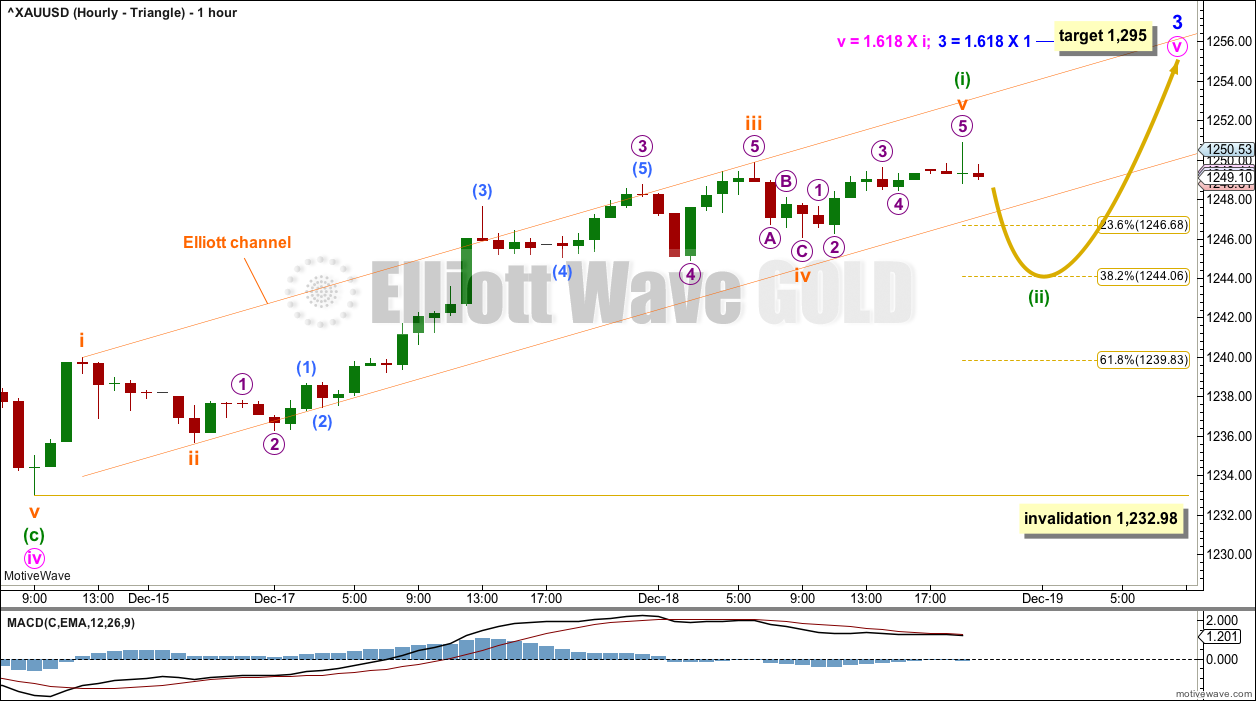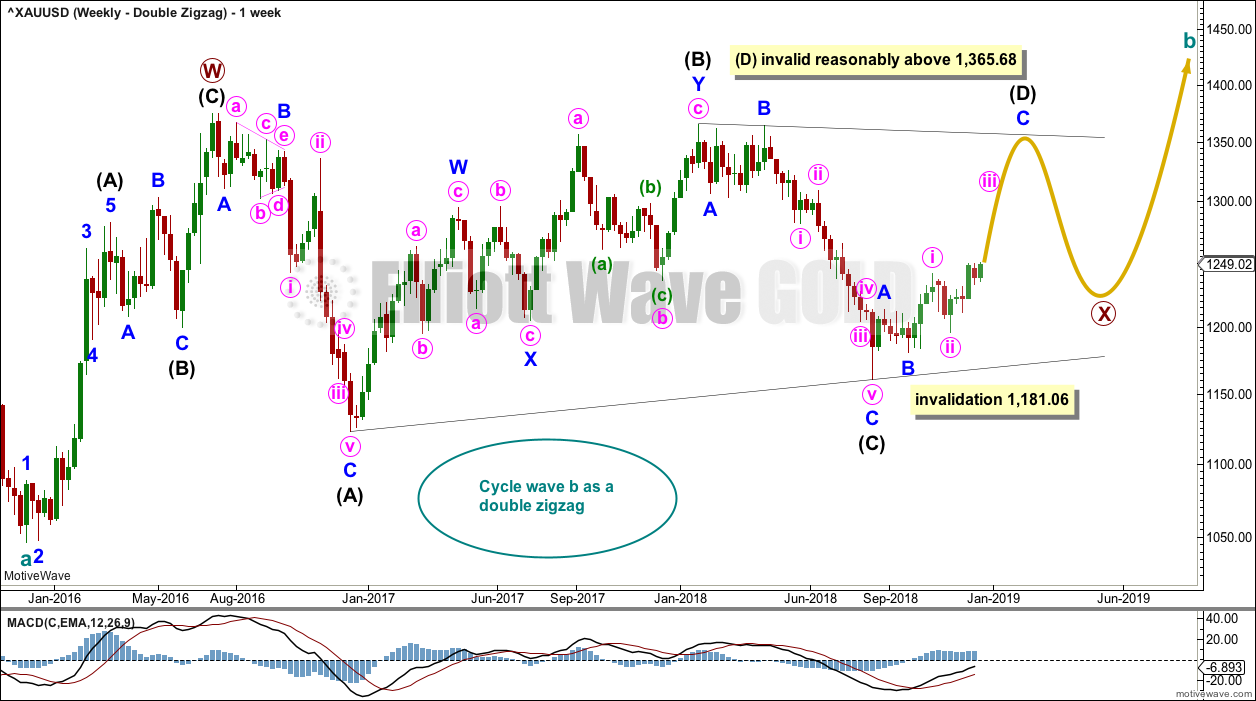Upwards movement continues as the preferred Elliott wave count expects. A slight new high now changes the Elliott wave structure for two of the four Elliott wave counts.
Summary: The mid-term target is 1,295.
The final target for this bounce to end is about 1,305 – 1,310.
New updates to this analysis are in bold.
Grand SuperCycle analysis is here.
Last historic analysis with monthly charts is here.
There are four remaining weekly wave counts at this time for cycle wave b: a triangle, a flat, a combination, and a double zigzag.
At this time, the Triangle wave count may again be slightly more likely.
MAIN ELLIOTT WAVE COUNT
WEEKLY CHART – TRIANGLE
Cycle wave b may be an incomplete regular contracting triangle. Primary wave E may not move beyond the end of primary wave C above 1,365.68.
Within primary wave E, intermediate waves (A) and (B) may be complete. Intermediate wave (C) must subdivide as a five wave structure. Within intermediate wave (C), minor wave 2 may not move beyond the start of minor wave 1 below 1,181.06.
Four of the five sub-waves of a triangle must be zigzags, with only one sub-wave allowed to be a multiple zigzag. Wave C is the most common sub-wave to subdivide as a multiple, and this is how primary wave C for this example fits best. Primary wave E would most likely be a single zigzag. It is also possible that it may subdivide as a triangle to create a rare nine wave triangle.
There are no problems in terms of subdivisions or rare structures for this wave count. It has an excellent fit and so far a typical look.
When primary wave E is a complete three wave structure, then this wave count would expect a cycle degree trend change. Cycle wave c would most likely make new lows below the end of cycle wave a at 1,046.27 to avoid a truncation.
It is possible now that primary wave E may end close to the end of December, or early in January 2019. Some reasonable weakness should be expected at its end. Triangles often end with declining ATR, weak momentum and weak volume.
DAILY CHART – TRIANGLE
Primary wave E may now be nearing its final stages for this wave count.
Primary wave E should subdivide as a zigzag. Intermediate waves (A) and (B) may now be complete. Intermediate wave (C) may be underway.
Within intermediate wave (C), minor wave 1 fits perfectly as a five wave impulse. Minor wave 2 is a deep zigzag.
Minor wave 3 may be an almost complete impulse, now beginning the final fifth wave. The target is now calculated at two degrees and so has a higher probability.
Gold often exhibits swift strong fifth waves. This tendency is especially prevalent in fifth waves to end third wave impulses. Look out for a possible blow off top to end minute wave v of minor wave 3.
Although the triangle for cycle wave b is expected to end with weakness, it is still possible that a smaller blow off top may occur at the end of minor wave 3 just ahead.
If it continues further, minute wave iv may not move into minute wave i price territory below 1,229.40.
A target for primary wave E is the strong zone of resistance about 1,305 to 1,310. Primary wave E is most likely to subdivide as a zigzag (although it may also subdivide as a triangle to create a rare nine wave triangle). It may last a total Fibonacci 21 or 34 weeks. So far it has lasted 13 weeks. Primary wave E may not move beyond the end of primary wave C above 1,365.68.
HOURLY CHART – TRIANGLE
The hourly chart focusses on the start of minute wave v. Minute wave v must subdivide as a five wave structure, either an impulse or ending diagonal. An impulse is much more likely as these are more common structures.
So far minuette wave (i) may now be complete. The channel is redrawn using Elliott’s first technique.
Use the channel as a guide to when minuette wave (i) is over. When the channel is breached by downwards movement, that would add confidence that minuette wave (i) is complete and minuette wave (ii) has then begun. Use the 0.382 and 0.618 Fibonacci ratios as targets for minuette wave (ii) to end, favouring the 0.382 Fibonacci ratio.
Minuette wave (ii) may not move beyond the start of minuette wave (i) below 1,232.98.
WEEKLY CHART – DOUBLE ZIGZAG
It is possible that cycle wave b may be a double zigzag or a double combination.
The first zigzag in the double is labelled primary wave W. This has a good fit.
The double may be joined by a corrective structure in the opposite direction, a triangle labelled primary wave X. The triangle would be about three quarters complete.
Within the triangle of primary wave X, intermediate wave (C) should be complete. Within intermediate wave (D), minor waves A and B may be complete. Minor wave C must subdivide as a five wave structure. Within minor wave C, minute wave ii may not move beyond the start of minute wave i below 1,181.06.
Intermediate wave (D) would most likely subdivide as a single zigzag.
This wave count may now expect choppy overlapping movement in an ever decreasing range for several more months.
Primary wave Y would most likely be a zigzag because primary wave X would be shallow; double zigzags normally have relatively shallow X waves.
Primary wave Y may also be a flat correction if cycle wave b is a double combination, but combinations normally have deep X waves. This would be less likely.
This wave count has good proportions and no problems in terms of subdivisions.
WEEKLY CHART – COMBINATION
If cycle wave b is a combination, then the first structure in a double may be a complete zigzag labelled primary wave W.
The double may be joined by a three in the opposite direction, a zigzag labelled primary wave X.
The second structure in the double may be a flat correction labelled primary wave Y. My research on Gold so far has found that the most common two structures in a double combination are one zigzag and one flat correction. I have found only one instance where a triangle unfolded for wave Y. The most likely structure for wave Y would be a flat correction by a very wide margin, so that is what this wave count shall expect.
Within a flat correction for primary wave Y, the current downwards wave of intermediate wave (B) may be a double zigzag. Intermediate wave (B) must retrace a minimum 0.9 length of intermediate wave (A) at 1,147.34. Intermediate wave (B) may move beyond the start of intermediate wave (A) as in an expanded flat.
No upper invalidation point is given on this chart. Minor wave X may still continue higher. There is no Elliott wave rule stating a minimum nor maximum length for X waves within multiples.
Because the minimum requirement for intermediate wave (B) is not yet met, this wave count requires that intermediate wave (B) continues lower. This is the most immediately bearish of all weekly wave counts.
When intermediate wave (B) is complete, then intermediate wave (C) would be expected to make at least a slight new high above the end of intermediate wave (A) at 1,365.68 to avoid a truncation. Primary wave Y would be most likely to end about the same level as primary wave W at 1,374.91, so that the whole structure takes up time and moves price sideways, as that is the purpose of double combinations.
While double combinations are very common, triples are extremely rare. I have found no examples of triple combinations for Gold at daily chart time frames or higher back to 1976. When the second structure in a double is complete, then it is extremely likely (almost certain) that the whole correction is over.
DAILY CHART – COMBINATION
A slight new high just prior to publication of this analysis has invalidated the double zigzag structure for minor wave X. Minor wave X now only fits as a possible triple zigzag.
While double zigzags are fairly common, triples are reasonably rare. I have found four examples at the daily chart level or higher for Gold back to 1976.
However, X waves within multiple zigzags (which is the structure seen here for intermediate wave (B) ) are very rarely themselves multiples.
The probability of this wave count is substantially reduced today. It no longer warrants an hourly chart.
Within multiple zigzags, there is no Elliott wave rule stating where wave X may not go. However, there is a convention which expects wave X to be relatively brief and shallow. X waves of multiple zigzags almost never move beyond the start of wave W (or Y) which immediately precedes it. If minute wave x moves lower, it should not move below the start of minute wave w at 1,196.39.
WEEKLY CHART – FLAT
The flat wave count is today discarded based upon a very low probability. Current upwards movement would have to now be seen as a triple zigzag. The rarity of this structure with the disproportion between a second and fourth wave has reduced the probability of that wave count so greatly it should not be seriously considered.
TECHNICAL ANALYSIS
WEEKLY CHART

Click chart to enlarge. Chart courtesy of StockCharts.com.
On Balance Volume has made a lower low than its prior low at the end of November 2015. This divergence is extremely bearish but does not rule out a consolidation unfolding here; the divergence does strongly support the Triangle wave count, which expects a consolidation or bounce up to test resistance now and then a continuation of a major bear market. It could also support the flat wave count that allows for a new low below 1,046.27 in coming months.
Last week completed an upwards week with a higher high and a higher low, but the candlestick is red and the balance of volume is downwards. Downwards movement within last week does not have support from volume.
DAILY CHART

Click chart to enlarge. Chart courtesy of StockCharts.com.
Declining ATR is now quite stark, which supports the triangle wave count. This is normal behaviour for the end of B wave triangles.
An upwards trend is in place for the short term.
GDX WEEKLY CHART

Click chart to enlarge. Chart courtesy of StockCharts.com.
The downwards breakout below 20.80 resulted in a downwards trend which is now considered to be complete.
GDX DAILY CHART

Click chart to enlarge. Chart courtesy of StockCharts.com.
A close above 20.80 on an upwards day with support from volume takes GDX back into a highly congested zone.
The target of 16.02 following the downwards breakout on the 13th of August was not met, and may now not be met.
GDX is in an upwards trend. There is resistance above 21.75.
Published @ 09:23 p.m. EST.
—
Careful risk management protects your trading account(s).
Follow my two Golden Rules:
1. Always trade with stops.
2. Risk only 1-5% of equity on any one trade.







Hi Lara,
any update in the light of the Fed?
Hourly triangle count updated:
It looks like minuette (ii) was more brief and shallow than expected. It did breach the channel, and reached about the 0.236 Fibonacci ratio.
Look out for a further increase in upwards momentum. A Christmas gift perhaps.